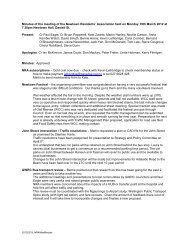Draft Town Belt Management Plan - Wellington City Council
Draft Town Belt Management Plan - Wellington City Council
Draft Town Belt Management Plan - Wellington City Council
You also want an ePaper? Increase the reach of your titles
YUMPU automatically turns print PDFs into web optimized ePapers that Google loves.
“... as plunder always will be deemed a holy thing by some, from Governors down to city<br />
councillors, so almost as soon as granted, the <strong>Town</strong> <strong>Belt</strong> has been mutilated” 134 .<br />
In 1900 nearly 150 residents and landowners opposed the building of a plague hospital on the<br />
<strong>Town</strong> <strong>Belt</strong> at Berhampore. One citizen, James Wilson, took the matter to the Supreme Court, on<br />
the grounds that such a use was in breach of the trust under which the <strong>Town</strong> <strong>Belt</strong> was held as a<br />
public recreation ground. Although the Court decided against him, the urgent necessity of the<br />
bubonic plague scare at the time was a likely factor 135 . Certainly, the case illustrated the strength of<br />
citizen feeling about protecting the <strong>Town</strong> <strong>Belt</strong>.<br />
Controversy over <strong>Town</strong> <strong>Belt</strong> housing proposals featured regularly in the media from the 1950s<br />
through to the early 1980s. The alienation of Bayview Terrace across the <strong>Town</strong> <strong>Belt</strong> to the then<br />
French Embassy in 1970, also caused a furore, prompting an editorial in The Dominion entitled<br />
‘Another Chunk’ 136 which highlighted the history of <strong>Town</strong> <strong>Belt</strong> alienations.<br />
As mentioned above, Action for the Environment was proactive in the 1970s in urging the <strong>Council</strong><br />
to develop policy that recognised the <strong>Town</strong> <strong>Belt</strong>’s special legal and heritage status, and sought the<br />
return of former <strong>Town</strong> <strong>Belt</strong> land.<br />
Free access for all<br />
Another issue that sparked controversy had to do with the widely held view that the <strong>Town</strong> <strong>Belt</strong>,<br />
being a public recreation ground, should be freely accessible to all.<br />
From this viewpoint, sportsfields were acceptable, being open for anyone to use and to walk across.<br />
However, leasing land to private sports groups was another matter. This issue came to a head<br />
around 1908, when an Act was passed allowing up to 100 acres of <strong>Town</strong> <strong>Belt</strong> to be leased to sports<br />
clubs 137 . Those who opposed the Bill envisaged wealthy interest groups taking over parts of the<br />
<strong>Town</strong> <strong>Belt</strong> for exclusive use and, potentially charging members of the public for access on land that<br />
was held in trust for everyone’s benefit 138 .<br />
The anti-leasing lobby lost that particular battle but the question of exclusive rights has from time<br />
to time resurfaced since. One example is the concept of community gardens. Productive gardens on<br />
the <strong>Town</strong> <strong>Belt</strong> were readily accepted during the Depression and Second World War when there was<br />
a clear public benefit, but subsequent garden allotments and the shared community garden that<br />
has existed at Ohiro Park for many years, led to concerns about whether the general public was<br />
being excluded for the benefit of a few. The issue arose again in recent years with applications for<br />
inner city residents without their own garden space to be able to use <strong>Town</strong> <strong>Belt</strong> land. Eventually a<br />
licence was granted to Innermost Gardens group to develop a community garden at a site on <strong>Town</strong><br />
<strong>Belt</strong> in Mt Victoria.<br />
Similarly, those in defence of the <strong>Town</strong> <strong>Belt</strong>’s public sanctity have opposed occasional applications<br />
by private interests for long-term commercial enterprises on <strong>Town</strong> <strong>Belt</strong> land. Applicants of such<br />
proposals as a driving range at the Municipal Golf Links (1988) or a gondola and summit<br />
restaurant on Mt Victoria (1987) have argued that such uses would add to the recreational and<br />
visitor opportunities on the <strong>Town</strong> <strong>Belt</strong> but the ‘hands off the <strong>Town</strong> <strong>Belt</strong>’ lobby has generally been<br />
adamant in its opposition.<br />
Buildings<br />
The question of building on the <strong>Town</strong> <strong>Belt</strong> has also been debated, given the New Zealand<br />
Company’s instruction in 1839 that the <strong>Town</strong> <strong>Belt</strong> was not to be built on.<br />
134 Quoted in “Another Chunk,” editorial by James Hartley, The Dominion, 15 December 1970.<br />
135 Quinn, “The Origin and Development,” 59–62<br />
136 James Hartely, “Another Chunk,” editorial, The Dominion, 15 December 1970.<br />
137 <strong>Wellington</strong> (<strong>City</strong>) <strong>Town</strong> <strong>Belt</strong> Reserves Act 1908<br />
138 Cook, “Background Report,” 12<br />
<strong>Draft</strong> <strong>Town</strong> <strong>Belt</strong> <strong>Management</strong> <strong>Plan</strong> October 2012<br />
227





